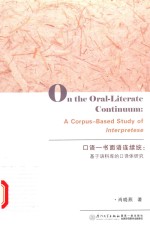

口语-书面语连续统 基于语料库的口译体研究PDF电子书下载
- 电子书积分:11 积分如何计算积分?
- 作 者:肖晓燕著
- 出 版 社:厦门:厦门大学出版社
- 出版年份:2015
- ISBN:9787561556184
- 页数:287 页
Chapter 1 Introduction 2
1.1 Research Background 2
1.1.1 The Primacy of Spoken Discourse 2
1.1.2 The Study of Translatese 4
1.1.3 Interpretese as Spoken and Translated Discourse 6
1.1.4 The Oral-Literate Continuum 8
1.2 Aims of the Study 9
1.3 Significance of the Study 11
1.4 Methodology and Data 14
1.4.1 Methodology 14
1.4.2 Data Selection 15
1.4.3 Data Preparation 18
1.4.4 Data Description 21
1.5 Structure of the Thesis 21
1.6 Terminology 23
Chapter 2 Literature Review 25
2.1 The Study of Language as Discourse 25
2.2 The Study of Spoken Discourse 29
2.2.1 Reawakening to the Primacy of Spoken Discourse 29
2.2.2 Spoken Discourse vs.Written Discourse 31
2.2.3 Orality vs.Literacy 35
2.3 Genre and Register 37
2.4 Corpus-Based Translation Studies 40
2.4.1 Impact of Corpus Linguistics 40
2.4.2 From“Equivalence”to“Norms” 41
2.4.3 Translatese and Translation Universals 42
2.4.4 The Study of Translatese in China 46
2.5 Corpus-Based Interpreting Studies 47
2.5.1 Challenges of Corpus-Based Interpreting Studies 48
2.5.2 Headways in Corpus-Based Interpreting Studies 49
2.5.3 Shlesinger's Work on Interpretese 51
2.5.4 Study on Interpretese in China 52
2.6 Evaluation of Previous Research 54
2.6.1 Inadequate Study of Interpretese as Spoken Discourse 54
2.6.2 Weakness in the Study of Interpretese as Translated Discourse 55
2.6.3 Issues with Chinese-English Interpreting Corpus 58
2.6.4 Methodological Issues of Studying Chinese-English Interpretese 59
Chapter 3 Theorectical Framework 60
3.1 G&RT as Conceptual Framework 60
3.1.1 Definition of Genre 60
3.1.2 Types and Functions of Genre 62
3.1.3 Differentiating Genre and Register 64
3.2 The MD Approach as Methodological Framework 66
3.2.1 The Dimensions 66
3.2.2 MD as a Macroscopic Approach 69
3.2.3 MD as a Microscopic Approach 70
3.2.4 MD as Quantitative and Qualitative Method 71
Chapter 4 Interpretese as a Genre 74
4.1 Defining Interpretese 74
4.1.1 Interpreting vs.Translating 75
4.1.2 I nterpretese Defined 79
4.1.3 Is Interpretese a Genre? 80
4.2 Describing Interpretese as a Genre 83
4.2.1 Modality 84
4.2.2 Ontology 85
4.2.3 Registers 86
4.3 Interpretese on the Oral-Literate Continuum 90
4.3.1 Zellermayer's Shifts on the Continuum 90
4.3.2 Shlesinger's Parameters of Orality 92
4.3.3 Biber's Dimensions of Orality 97
4.3.4 Measuring Orality:An Integrated Model 99
4.3.5 Modifying the Model for Chinese 111
Chapter 5 An MD Analysis of Interpretese 114
5.1 The Corpus 114
5.1.1 Strengths of the Current Corpus 114
5.1.2 Describing the Corpus 118
5.2 Selection of Linguistic Features 119
5.2.1 Dimension A:Involvedness 122
5.2.2 Dimension B:Constrainedness 126
5.2.3 Dimension C:Context-Boundedness 127
5.2.4 Dimension D:Abstractness 132
5.2.5 Dimension E:Prosody 133
5.3 Frequency Counts and Analysis 135
5.3.1 Dimension A 135
5.3.2 Dimension B 144
5.3.3 Dimension C 153
5.3.4 Dimension D 160
5.3.5 Dimension E 163
5.4 Gender as a Variable 169
5.4.1 Male Speakers vs.Female Speakers 169
5.4.2 Male Interpreters vs.Female Interpreters 171
5.5 Language Status as a Variable 174
5.5.1 English A Speakers vs.English B speakers 175
5.5.2 English A Interpreter vs.English B Interpreters 177
5.5.3 Chinese A Interpreters vs.Chinese B Interpreter 178
5.6 Factor Analysis 180
5.6.1 Why Factor Analysis? 180
5.6.2 Explaining Loadings 181
5.6.3 Identifying Factors 181
5.7 Interpreting the Data 186
Chapter 6 On the Oral-Literate Continum:Panel Discussions vs.Other Registers 186
6.1 Panel Discussion as a Register 188
6.2 Panel Discussions vs.Other Registers 190
6.2.1 Along the Continuum of Involvedness 191
6.2.2 Along the Continuum of Constrainedness 197
6.2.3 Along the Continuum of Context-Boundedness 200
6.2.4 Along the Continuum of Abstractness 204
6.2.5 A Multidimensional Description of Registers 205
Chapter 7 Conclusion 208
7.1 Findings from the Current Investigation 208
7.2 Significance and Implications 213
7.3 Limitations and Future Research 215
References 217
Appendices 242
Appendix 1 A sample of E-ST 242
Appendix 2 A sample of E-TT 250
Appendix 3 A sample of C-ST 262
Appendix 4 A sample of C-TT 266
Acknowledgements 287
- 《商务英语口译教程 第3版》朱佩芬,徐东风编著 2017
- 《口译理论研究》王斌华著 2019
- 《高考英语书面表达分类指导》赫贵祥 2019
- 《法语口译综合能力专项训练》陈伟主编 2019
- 《商务英语口译教程》尤彧聪,黎晓霖,张敏主编 2017
- 《现代伤口与肠造口临床护理实践》胡爱玲,郑美春,李伟娟主编;叶新梅,黄漫容副主编 2018
- 《商务馆翻译研究丛书 口译项目管理》(中国)王华树,李智 2019
- 《英语基础口译证书模考试卷汇编》王晓波,施红主编 2018
- 《机电技术笔口英汉互译系统方法 1 下》卜玉坤编著 1996
- 《语料库驱动的短语配价型式研究》甄凤超著 2019
- 《中风偏瘫 脑萎缩 痴呆 最新治疗原则与方法》孙作东著 2004
- 《水面舰艇编队作战运筹分析》谭安胜著 2009
- 《王蒙文集 新版 35 评点《红楼梦》 上》王蒙著 2020
- 《TED说话的力量 世界优秀演讲者的口才秘诀》(坦桑)阿卡什·P.卡里亚著 2019
- 《燕堂夜话》蒋忠和著 2019
- 《经久》静水边著 2019
- 《魔法销售台词》(美)埃尔默·惠勒著 2019
- 《微表情密码》(波)卡西亚·韦佐夫斯基,(波)帕特里克·韦佐夫斯基著 2019
- 《看书琐记与作文秘诀》鲁迅著 2019
- 《酒国》莫言著 2019
- 《大学计算机实验指导及习题解答》曹成志,宋长龙 2019
- 《大学生心理健康与人生发展》王琳责任编辑;(中国)肖宇 2019
- 《大学英语四级考试全真试题 标准模拟 四级》汪开虎主编 2012
- 《大学英语教学的跨文化交际视角研究与创新发展》许丽云,刘枫,尚利明著 2020
- 《复旦大学新闻学院教授学术丛书 新闻实务随想录》刘海贵 2019
- 《大学英语综合教程 1》王佃春,骆敏主编 2015
- 《大学物理简明教程 下 第2版》施卫主编 2020
- 《大学化学实验》李爱勤,侯学会主编 2016
- 《中国十大出版家》王震,贺越明著 1991
- 《近代民营出版机构的英语函授教育 以“商务、中华、开明”函授学校为个案 1915年-1946年版》丁伟 2017
